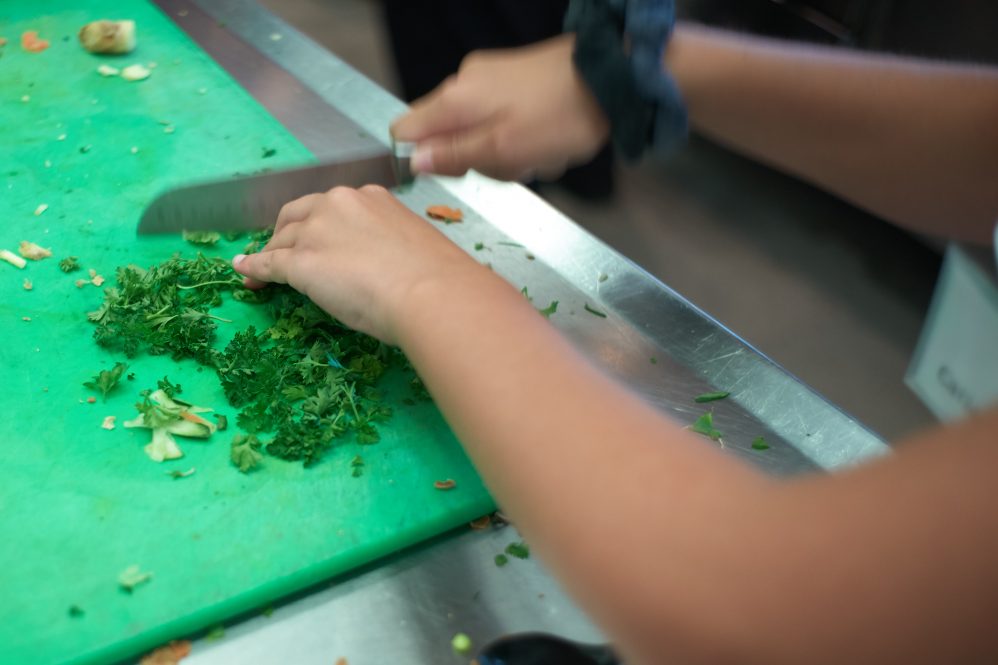The UConn Zwick Center for Food and Resource Policy in the College of Agriculture, Health and Natural Resources released a report on Farm to School activities in Connecticut, focusing on local food procurement.
The survey was prepared for the Connecticut Department of Agriculture, which received funding through the U.S. Department of Agriculture Farm to School Grant for the project. The Connecticut State Department of Education was a partner on the project. The study was conducted by Cristina Connolly, assistant professor in the Department of Agricultural and Resource Economics; Alyssa McDonnell, research assistant; and graduate research assistants Christine Dosseh and Jacob Gentile.
“The findings of this report will provide the agency and farm to school partners enhanced knowledge of what the current local procurement landscape is for Connecticut school food authorities and how that translates to market opportunities for Connecticut’s agricultural producers,” says Agriculture Commissioner Bryan P. Hurlburt. “Through the work of the UConn Zwick Center, we will be better informed to assist schools seeking local products and connecting them with local farmers to increase purchasing levels of CT Grown products.”
Farm to School is a nationwide initiative focused on introducing children to new, fresh foods and learning about where food comes from, through local food procurement and educational programs. Farm to School programs are determined at the district level. It is up to the individual director of the School Food Authority (SFA) if and how they purchase local food. This means there is significant diversity in how these programs are implemented in schools across the state.
The Zwick study included an online survey and a subset of phone interviews, developed with input from SFA directors.
“A lot of people in the school food communities were involved in the whole project from beginning to end,” Connolly says.
The survey found the variety of Farm to School in schools also extended to their definitions of “local.” Each SFA defined what was considered to be local produce differently. In some cases, the SFA didn’t have a definition at all. For some, “local” means food grown within 50 miles of the school, which, for districts on the border with Massachusetts or New York, may not be in Connecticut. For other schools “local” means grown anywhere in Connecticut. And for others, “local” includes anywhere in the Northeast.
Of the 149 Connecticut SFAs who responded, 101 had purchased some form of “local” food in the past year. However, the Zwick report found that, among schools with local food, very few are purchasing a majority in Connecticut.
While 83% of respondents who incorporated local food reported that some of their inventory came from Connecticut, for most, they only purchased about 10% of their food from within the state. Only four SFAs reported that more than 75% of their local spending is in Connecticut.
“Almost everyone is buying at least something from Connecticut,” Connolly says. “But for those who are buying a lot of local food, the bulk of it is spread out across the region. It is not specific to our state.”
The most common products SFAs purchase from Connecticut are apples, summer squash, and lettuce. The survey asked what SFAs would like to buy from Connecticut and found berries, herbs, and snap or green beans were the top choices.
Some considerations for schools in determining what they do or would like to buy locally are the processing requirements for various fruits and vegetables. For example, something like squash cannot be served raw, meaning schools need adequate staff, time, and equipment to process it, while berries, for example, can be served without any extensive preparation.
Another issue the survey identified is that many schools that do serve local foods have trouble marketing this fact to students and parents.
“Understandably, [directors] are not marketing people,” McDonnell says. “They’re already time- and resource-constrained and often have more immediate needs to address. But a big part of doing Farm to School is communicating it.”
At the end of the report, the Zwick team provides a series of recommendations for improving schools’ access to local foods.
One recommendation is the creation of a central, accessible information repository. Lack of information about how to reach farmers, the types and amount of food available, procurement regulations, and other basic questions are a major barrier.
The team would also like to reach out to large-scale distributors to learn more about their procurement processes, since they may be purchasing locally without advertising this fact.
Another recommendation is to improve access to funding and equipment resources as some schools lack basic equipment like food storage containers or refrigerators, severely limiting their ability to prepare and store fresh produce.
“Once you get over that initial obstacle of adequately investing in a kitchen with equipment, invest in the equipment and staff training, it does become standard,” Connelly says. “Once you’ve done that, it goes more smoothly.”
This survey represents a remarkable commitment on the part of both the research team and SFAs, as it had an 86% response rate, an impressively high statistic in the field.
“This response rate is out of the park,” says Kimberly Rollins, head of the Department of Agricultural and Resource Economics. “It reflects the extremely high quality of and attention to the work at hand.”
This work relates to CAHNR’s Strategic Vision area focused on Ensuring a Vibrant and Sustainable Agricultural Industry and Food Supply.
Follow UConn CAHNR on social media



